
The House of Romanov was the reigning royal house of Russia from 1613 to 1917.
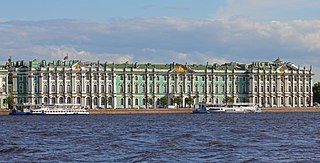
The State Hermitage Museum is a museum of art and culture in Saint Petersburg, Russia. The second-largest art museum in the world, it was founded in 1764 when Empress Catherine the Great acquired an impressive collection of paintings from the Berlin merchant Johann Ernst Gotzkowsky. The museum celebrates the anniversary of its founding each year on 7 December, Saint Catherine's Day. It has been open to the public since 1852.

The Alexander Palace is a former imperial residence near the town of Tsarskoye Selo, on a plateau about 30 miles (48 km) south from the imperial capital city of St. Petersburg. It is known as the favourite residence of the last Russian Emperor (Tsar/Czar), Nicholas II, and his imperial family, and served as their initial place of imprisonment after the first of two Russian Revolutions in February of 1917 that overthrew the Romanov during World War I (1914–1918). The Alexander Palace is situated in the Alexander Park, not far from the larger, more elaborate Catherine Palace, begun in 1717 by Empress/Tsarina Catherine I of Russia and significantly expanded by Catherine the Great. Today it is undergoing renovation as a state museum housing relics of the former imperial dynasty.

A throne room or throne hall is the room, often rather a hall, in the official residence of the crown, either a palace or a fortified castle, where the throne of a senior figure is set up with elaborate pomp—usually raised, often with steps, and under a canopy, both of which are part of the original notion of the Greek word thronos.

The Imperial Crown of Russia, also known as the Great Imperial Crown, was used by the monarchs of Russia from 1762 until the Russian monarchy's abolition in 1917. The Great Imperial Crown was first used in a coronation by Catherine the Great, and it was last worn at the coronation of Nicholas II. It was displayed prominently next to Nicholas II on a cushion at the State Opening of the Russian Duma inside the Winter Palace in St. Petersburg in 1906. It survived the 1917 revolution and is currently on display in Moscow at the Kremlin Armoury's State Diamond Fund.

The Military Gallery is a gallery of the Winter Palace in Saint Petersburg, Russia. The gallery is a setting for 332 portraits of generals who took part in the Patriotic War of 1812. The portraits were painted by George Dawe and his Russian assistants Alexander Polyakov (1801-1835), a serf, and Wilhelm August Golicke.

The Hermitage Theatre in Saint Petersburg, Russia is one of five Hermitage buildings lining the Palace Embankment of the Neva River.
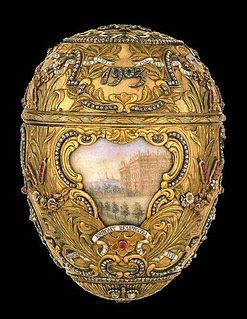
The Peter the Great Egg is a jewelled Easter egg made under the supervision of the Russian jeweler Peter Carl Fabergé in 1903 for the last Tsar of Russia, Nicholas II. Tsar Nicholas presented the egg to his wife, the Czarina Alexandra Fyodorovna. The egg is currently located at the Virginia Museum of Fine Arts in Richmond, Virginia, in the United States.
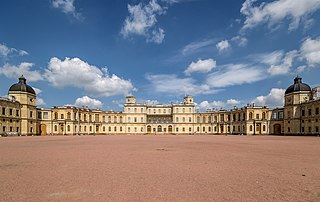
The Great Gatchina Palace is a palace in Gatchina, Leningrad Oblast, Russia. It was built from 1766 to 1781 by Antonio Rinaldi for Count Grigori Grigoryevich Orlov, who was a favourite of Catherine the Great, in Gatchina, a suburb of the royal capital Saint Petersburg. The Gatchina Palace combines classical architecture and themes of a medieval castle with ornate interiors typical of Russian classicism, located on a hill in central Gatchina next to Lake Serebryany. The Gatchina Palace became one of the favourite residences of the Russian Imperial Family, and during the 19th century was an important site of Russian politics. Since the February Revolution in 1917 it has been a museum and public park, and received UNESCO World Heritage Site status in 1990.

The Winter Palace was the official residence of the Russian Emperors from 1732 to 1917. Today, the palace and its precincts form the Hermitage Museum. Situated between Palace Embankment and Palace Square, in Saint Petersburg, adjacent to the site of Peter the Great's original Winter Palace, the present and fourth Winter Palace was built and altered almost continuously between the late 1730s and 1837, when it was severely damaged by fire and immediately rebuilt. The storming of the palace in 1917, as depicted in Soviet propaganda art and Sergei Eisenstein's 1927 film October, became an iconic symbol of the Russian Revolution.
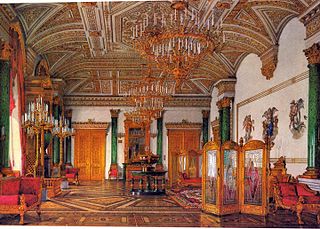
The Malachite Room of the Winter Palace, St Petersburg, was designed in the late 1830s by the architect Alexander Briullov for use a formal reception room for the Empress Alexandra Fyodorovna, wife of Nicholas I. It replaced the Jasper Room, which was destroyed in the fire of 1837.

The principal or Jordan Staircase of the Winter Palace, St Petersburg is so called because on the Feast of the Epiphany the Tsar descended this imperial staircase in state for the ceremony of the "Blessing of the Waters" of the Neva River, a celebration of Christ's baptism in the Jordan River. The staircase is one of the few parts of the palace retaining the original 18th-century style. The massive grey granite columns, however, were added in the mid 19th century.

The Field Marshals' Hall of the Winter Palace in Saint Petersburg was built to honor Imperial Russia's greatest military leaders—Russian generals who attained the rank of Field Marshal..

St George's Hall is one of the largest state rooms in the Winter Palace, St Petersburg. It is located on the eastern side of the palace, and connected to The Hermitage by the smaller Apollo Room.

The Grand Church of the Winter Palace in Saint Petersburg, sometimes referred to as the Winter Palace's cathedral, was consecrated in 1763. It is located on the piano nobile in the eastern wing of the Winter Palace, and is the larger, and principal, of two churches within the Palace. A smaller, more private church was constructed in 1768, near the private apartment in the northwest part of the wing. The Grand Church was designed by Francesco Rastrelli, and has been described as "one of the most splendid rooms" in the Palace. Today, the church is an unconsecrated exhibition hall of the State Hermitage Museum.
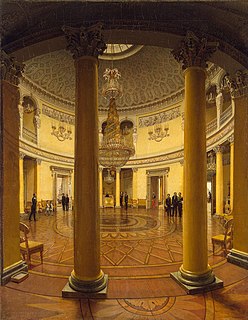
The Rotunda of the Winter Palace in St Petersburg is a circular hall in the northwest wing of the palace created for Tsar Nicholas I by the architect Auguste de Montferrand. Designed in a circular neoclassical temple style, it served as an anteroom, vestibule and link between the more public state rooms of the palace and the more intimate rooms used by the Imperial family. The room is domed and top lit by an oculus.
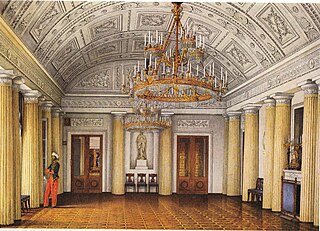
The Arabian Hall, sometimes known as the Blackamoor Hall or the Arabian Dining Room, is one of the private rooms of the Winter Palace in Saint Petersburg. In the Tsarist era, it was the room from which imperial processions through the state rooms began. The double doors were designed to be on a straight axis through the principal state rooms and ultimately the Jordan Staircase, forming an enfilade. Thus it was here the Romanov family often assembled, in private, before state receptions and occasions. The privacy of the room was not compromised by the small private courtyard from which windows, which once led to the Tsaritsa's winter-garden below, admitted light.

The Neva Enfilade of the Winter Palace, St Petersburg, is a series of three large halls arranged in an enfilade along the palace's massive facade facing the River Neva.

The Private Apartments of the Winter Palace are sited on the piano nobile of the western wing of the former imperial palace, the Winter Palace in St Petersburg. Access to the private rooms, for members of the Imperial Family, from the exterior was usually through the Saltykov Entrance which was reserved for use by only the Tsar, Tsaritsa and grand dukes and grand duchesses. A second access was through a discrete box-like porch, on the western end of the Palace's Neva façade. From the ground floor, it can be accessed from the October Staircase, formerly known as His Majesty's Own Staircase; this double-flighted imperial staircase was a secondary entrance to the private apartments, and provided a more convenient route to the palace's ground floor and private entrances than the more formal and ceremonial public route through the state apartments. During the October Revolution of 1917, this was the entrance by which the revolutionaries gained access to the palace in order to arrest the Provisional Government in the small private dining room. Since that date it has been known as the October Staircase and has a plaque commemorating the event. Despite its size and grandeur, the October Staircase was a secondary staircase, the Jordan Staircase being the principal.





















